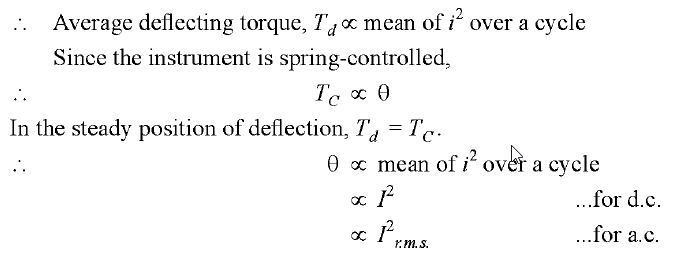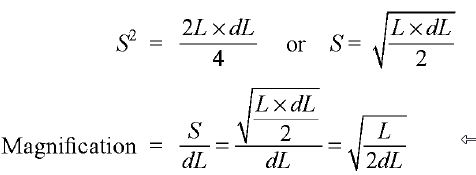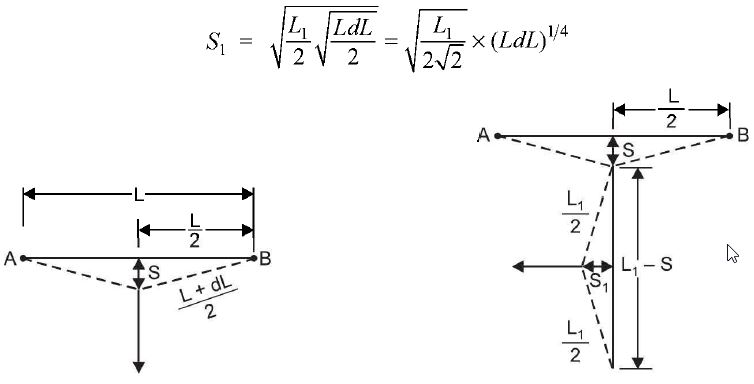Electrical Engineering ⇒ Topic : Hot-Wire Ammeters and Voltmeters construction and working
|
|
| Maninder
| |
Hot-Wire Ammeters and Voltmeters The operation of these instruments depends upon the expansion of a wire which is heated due to the passage of electric current. The expansion of the wire is taken up by the moving system which causes the pointer to move over a graduated scale. They are suitable for d.c. as well as a.c. measurements. figure (a) Construction. Fig. (a) shows the simplified diagram of a hot-wire instrument. It consists of a very thin platinum-iridium wire AB stretched between terminals A and B. The wire AB is generally called the hot-wire and carries the operating current of the instrument. A fine phosphor-bronze wire CD (called tension wire) is attached to the centre C of the hot-wire; the other end D being fixed to the base of the instrument. A fine silk thread attached to CD at E passes around a pulley on the spindle and is connected to a spring F. The effect of wire CD and the silk thread is to *magnify the expansion of the wire AB. A pointer is attached to the spindle which moves over the scale as the hot-wire AB expands. A thin light aluminium disc is attached to the pulley and moves between the poles of a permanent magnet M. Eddy currents produced in the disc provide the necessary damping. The instrument is generally spring controlled. Working. When the instrument is connected in the circuit to measure current or voltage, the operating current flows through the hot-wire AB. This causes the hot-wire to expand. The slack in the hot-wire is taken up by the spring F, causing the pulley P to turn and move the pointer over the scale. When the operating current ceases to flow, the wire AB cools and contracts, and the silk thread is pulled to the right causing the pointer to return to zero. Since the tension of wire AB changes with temperature, the pointer is set to zero (with adjustment screw) practically each time the instrument is to be used. As the heating effect of electric current is independent of the direction of current flow, therefore, such instruments can be used for both d.c. and a.c. work. Deflecting torque. The expansion of the hot-wire depends upon i2R loss where i is the instantaneous current through the hot wire AB.
Note that deflection is directly proportional to the square of current through the hot-wire. If current is increased two times, the deflection is increased four times. Hence such instruments have square-law scale; being crowded in the beginning and open near the end of the scale. Magnification of expansion. When operating current flows through the hot-wire, the sag produced is much greater than the actual expansion of the wire. For this reason, we utilise the effect of sag in hot-wire instruments. In Fig. (a), AB is the hot-wire. Let L be the length of the wire AB and dL its expansion after steady temperature is reached. The sag S produced in the wire Refer to Fig. (a) is given by ; Since dL is very small compared to L, (dL)2 can be neglected.
It may be seen that the value of S/dL is much greater than 1. Further magnification is obtained by connecting a phosphor bronze wire of length L1 to the centre of wire AB as shown in Fig.(b). Let S1 be the sag of phosphor bronze wire. Referring to Fig.(b), Putting the value of S in the above expression, we get, (a) (b) figure | |
|
| |
| Maninder
| |
Hot-Wire Ammeters and Voltmeters The operation of these instruments depends upon the expansion of a wire which is heated due to the passage of electric current. The expansion of the wire is taken up by the moving system which causes the pointer to move over a graduated scale. They are suitable for d.c. as well as a.c. measurements. figure (a) Construction. Fig. (a) shows the simplified diagram of a hot-wire instrument. It consists of a very thin platinum-iridium wire AB stretched between terminals A and B. The wire AB is generally called the hot-wire and carries the operating current of the instrument. A fine phosphor-bronze wire CD (called tension wire) is attached to the centre C of the hot-wire; the other end D being fixed to the base of the instrument. A fine silk thread attached to CD at E passes around a pulley on the spindle and is connected to a spring F. The effect of wire CD and the silk thread is to *magnify the expansion of the wire AB. A pointer is attached to the spindle which moves over the scale as the hot-wire AB expands. A thin light aluminium disc is attached to the pulley and moves between the poles of a permanent magnet M. Eddy currents produced in the disc provide the necessary damping. The instrument is generally spring controlled. Working. When the instrument is connected in the circuit to measure current or voltage, the operating current flows through the hot-wire AB. This causes the hot-wire to expand. The slack in the hot-wire is taken up by the spring F, causing the pulley P to turn and move the pointer over the scale. When the operating current ceases to flow, the wire AB cools and contracts, and the silk thread is pulled to the right causing the pointer to return to zero. Since the tension of wire AB changes with temperature, the pointer is set to zero (with adjustment screw) practically each time the instrument is to be used. As the heating effect of electric current is independent of the direction of current flow, therefore, such instruments can be used for both d.c. and a.c. work. Deflecting torque. The expansion of the hot-wire depends upon i2R loss where i is the instantaneous current through the hot wire AB.
Note that deflection is directly proportional to the square of current through the hot-wire. If current is increased two times, the deflection is increased four times. Hence such instruments have square-law scale; being crowded in the beginning and open near the end of the scale. Magnification of expansion. When operating current flows through the hot-wire, the sag produced is much greater than the actual expansion of the wire. For this reason, we utilise the effect of sag in hot-wire instruments. In Fig. (a), AB is the hot-wire. Let L be the length of the wire AB and dL its expansion after steady temperature is reached. The sag S produced in the wire Refer to Fig. (a) is given by ; Since dL is very small compared to L, (dL)2 can be neglected.
It may be seen that the value of S/dL is much greater than 1. Further magnification is obtained by connecting a phosphor bronze wire of length L1 to the centre of wire AB as shown in Fig.(b). Let S1 be the sag of phosphor bronze wire. Referring to Fig.(b), Putting the value of S in the above expression, we get, (a) (b) figure | |
|
| |
!! OOPS Login [Click here] is required for more results / answer







